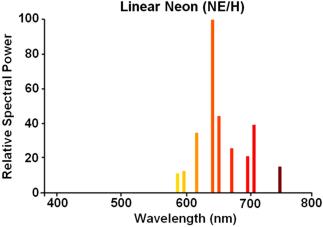
|
Thorn 160W Linear Neon Airfield Hazard Lamp |

The principal spectral energy is at 640 nanometres, and it is designed to operate either as a static source or, by means of an electronic switching unit, to operate as an occulting beacon with flashes up to 180 per minute.
The glass bulb shares the same tubular dented design of the early SLI lamps. The glass is ordinary soda lime silicate since neon, of course, does not have the same chemically corrosive behaviour that sodium exhibits in contact with most glasses. The electrodes are essentially beefed-up fluorescent electrodes designed to carry the higher current. The central cathode portion is fabricated from seven fine black tungsten wires braided into a hollow tube, and then coiled around a mildly radioactive thoria pellet which assists in electron emission. The whole is thickly coated with barium-strontium-calcium carbonate emitter. To reduce the electrical and thermal loading on the cathode coil thereby extending its life, it is flanked by a pair of molybdenum anode plates. A barium getter at each end of the lamp helps to maintain ultra high purity of the neon-argon gas filling.
Remarkably this lamp is still in production today at GE Lighting's Leicester factory, with the grand total of some 40 per month being sold to Thorn Lighting's Airfield Division.

| Manufacturer: | Thorn Lighting Ltd. | |
| Lamp Power: | 160 Watts | |
| Lamp Current: | 1.33 Amps | |
| Lamp Voltage: | 157 Volts | |
| Cap: | 2x G13/10x24 | Aluminium + Paxolin insulator |
| Bulb Finish: | Clear | |
| Bulb Type: | TD-26 | |
| Overall Length: | 35.78" | |
| Lighted Length: | 31.375" | |
| Electrodes: | Braided tungsten over a thoria pellet | |
| Atmosphere: | 98.5% Neon, 1.5% Argon | |
| Luminous Flux: | 2,000 lumens (Initial) | 1,850 lumens (4,000 hrs) |
| Luminous Efficacy: | 12.5 lumens per watt | |
| Colour Temperature & CRI: | CCT: N/A | CRI: N/A |
| Chromaticity Co-ordinates: | CCx: 0.674 | CCy: 0.326 |
| Rated Life: | 4,000 hours | 30 million flashes |
| Factory: | Leicester | England |
| Date of Manufacture: | June 1990 | |
| Original / Present Value: | GB £485.00 (2001) | |
